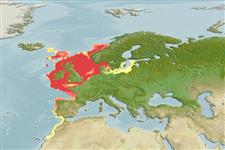>
Gadiformes (Cods) >
Gadidae (Cods and haddocks)
Etymology: Trisopterus: Greek, tris = thrice + Greek, pteron = wing, fin (Ref. 45335).
More on author: Linnaeus.
Issue
The species has been long thought to be present in the Mediteranean in sympatry with Trisopterus capelanus, sometimes both as subspecies. See Delling et al. (2011: Ref. 90172) for the latest revision of the genus.
Environment: milieu / climate zone / depth range / distribution range
Ecologie
marien benthopelagisch; standvastig; diepte 1 - 440 m (Ref. 57178), usually 15 - 200 m. Temperate; 66°N - 28°N, 13°W - 36°E
Northeastern Atlantic: Trondheim Fjord and the Faeroe Islands to Portugal and along the Atlantic coast of Morocco (Ref. 1371). Not present in the Mediterranean (Ref. 90172).
Lengte bij maturiteit / Grootte / Gewicht / Leeftijd
Maturity: Lm 13.3, range 10 - 26 cm
Max length : 40.0 cm TL mannelijk / geslacht onbekend; (Ref. 1371); common length : 20.0 cm TL mannelijk / geslacht onbekend; (Ref. 4645); max. gerapporteerde leeftijd: 5 Jaren (Ref. 72488)
Dorsale stekels (totaal) : 0; Anale stekels: 0. Chin barbel well developed. Body brownish yellow dorsally, becoming paler ventrally; a dark blotch is at the base of the pectoral fin.
Occurs mostly from 15 to 200 m in the Atlantic on muddy or sandy bottoms. Feeds on crustaceans, small fish, and polychaetes (Ref. 1371). Used in the production of fish meal, and in southern Europe as a human food (Ref. 35388).
Oviparous, sexes are separate (Ref. 205).
Cohen, D.M., T. Inada, T. Iwamoto and N. Scialabba, 1990. FAO species catalogue. Vol. 10. Gadiform fishes of the world (Order Gadiformes). An annotated and illustrated catalogue of cods, hakes, grenadiers and other gadiform fishes known to date. FAO Fish. Synop. 125(10). Rome: FAO. 442 p. (Ref. 1371)
Status op de Rode Lijst van het IUCN (Ref. 130435)
Gevaar voor de mens
Harmless
Gebruik door de mens
Visserij: commercieel
Tools
Speciale rapporten
Download XML
Internetbronnen
Estimates based on models
Preferred temperature (Ref.
123201): 7.2 - 13, mean 10 °C (based on 1312 cells).
Fylogenetische diversiteitsindex (Ref.
82804): PD
50 = 0.5625 [Uniqueness, from 0.5 = low to 2.0 = high].
Bayesian length-weight: a=0.00741 (0.00662 - 0.00830), b=3.11 (3.08 - 3.14), in cm total length, based on LWR estimates for this species (Ref.
93245).
Trofisch niveau (Ref.
69278): 3.7 ±0.2 se; based on diet studies.
Generation time: 2.7 (2.2 - 4.2) years. Estimated as median ln(3)/K based on 10
growth studies.
Weerstandsvermogen (Ref.
120179): Gemiddeld, minimale populatieverdubbelingstijd 1,4-4,4 jaar (K=0.18; tm=1; tmax=6).
Prior r = 0.54, 95% CL = 0.35 - 0.81, Based on 2 full stock assessments.
Fishing Vulnerability (Ref.
59153): Moderate vulnerability (37 of 100).
Climate Vulnerability (Ref.
125649): Low vulnerability (7 of 100).
Nutrients (Ref.
124155): Calcium = 66.1 [16.9, 219.6] mg/100g; Iron = 0.674 [0.145, 2.965] mg/100g; Protein = 18.3 [15.8, 20.4] %; Omega3 = 0.701 [0.351, 1.389] g/100g; Selenium = 19.3 [9.3, 38.8] μg/100g; VitaminA = 16.6 [3.8, 72.1] μg/100g; Zinc = 1.13 [0.27, 3.13] mg/100g (wet weight); based on
nutrient studies.
